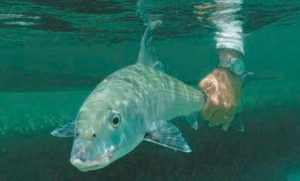Dr. Jennifer Rehage, fish ecologist and associate professor at Florida International University, has been chasing “gray ghosts” for 15 years trying to tally its declining numbers. She wants to know why bonefish numbers are dropping. She will be sharing what she has learned about bonefish at 7:30 p.m. Wednesday, March 1, at the John Pennekamp Coral Reef State Park visitor center as part of its free “Delicate Balance of Nature” lecture series. Rehage is heading an ecological study that includes more than 35 years of data on water quality, climate, seagrass cover and abundance and distribution of prey, as well as angler catches and effort. She’s analyzed changes to the natural hydrology of the Everglades and how that may affect bonefish fisheries. Since the 1980s, angler catches of bonefish have steadily decreased in Florida Bay and the Upper Keys, Rehage says, and that has her concerned.

Little is known about bonefish populations mostly because it is a catch-and-release recreational fishery. Rehage’s research utilizes fishing guides’ reports and collective surveyed data. “In the absence of any other data, we took licensed fishing guide reports throughout the Everglades, although the data does have some caveats,” she said. “There were 5,000 reports filed since 1980. We are looking into when [bonefish] started to decline. When is a big question. What is happening in the bay?” Rehage also interviewed about 260 fishing captains and asked them about the quality of fishing. Anglers reported when bonefish catches had been good or bad to Rehage and her team. Some of her reports go back 40 years. Rehage told the Free Press that in late 1999 and early 2000 data shows there was a major drop in bonefish numbers. She said she’s looking into a multitude of factors to find out what exactly caused the breaking point. It could have been algae blooms, relatively higher fishing activity in the ‘90s, fishing pressure or a number of other factors. She said her data shows loss of habitat for adult and juvenile bonefish due to development and water quality issues.
Bonefish are most affected by hydrology changes in the upper Florida Bay. “Even if the declines in catches are due to bonefish moving into new territories and not to a decline in their population numbers, the declines are likely indicative of habitat degradation,” Rehage said. Rehage also said another big decline in bonefish numbers in Florida Bay occurred in 2010 after a major cold snap in the Keys. Bonefish are sight-casted. They fight hard and spook easily earning the name “gray ghosts.” Bonefish mature at three to four years of age, may live longer than 23 years and can grow to be 3 feet long and 15 pounds. Bonefish can be caught year-round in the Keys, but peak bonefish season is generally March through October. Rehage said bonefish mortality from shark predation can be really high — one study shows a third of the released fish are eaten by sharks. But, she added that in the past year, it seems that the species is rebounding.
There seems to be more younger fish, which indicates that they were born after the cold snap. “A few schools have been reported,” she said. “That is encouraging.” Rehage’s three-year study at FIU is funded by the Bonefish & Tarpon Trust, an organization dedicated to conserving bonefish, tarpon and permit fisheries. Its website estimates that flats fishing’s financial impact on the Florida Keys is $465 million annually. Mark Rehbein, the organization’s director of development, said Rehage’s work is extremely important. He caught his first bonefish when he was 8 or 9-yearsold. “The value of a single bonefish in the Keys is amazing and the amount of tourism traffic they generate,” Rehbein said. He says each bonefish generates roughly $3,000. Seating is limited for Rehage’s lecture at John Pennekamp Coral Reef State Park, mile marker 102.5, oceanside. Admission to the park and lecture is free. Doors open at 7 p.m. For more information, contact Elena Muratori at 305-451- 1202.
